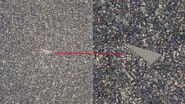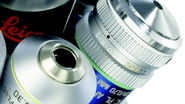Eyepieces
The eyepieces are the optical lenses where we see the final images of specimens (see Figure 1). These optics are sometimes referred to as ‘ocular lenses’ or ‘oculars’. As well as the magnification which is dependent on objective selection, there is an additional magnification factor from the eyepieces to consider which is usually in the order of a 10x magnification. An eyepiece looks like a deceptively simple optical component of the microscope. Whilst it is true that some of the basic eyepieces are comprised of a a metal tube with lenses top and bottom, many of the research grade eyepieces consist of groups of lenses designed to work in conjunction with each other to give a corrected view of your specimen as well as complimenting the properties of the objectives.
Regardless of the component design of the eyepiece, there are only two lenses at either end of the metal housing which are visible to the user. The lenses through which the final image is viewed (closest to eyes) are referred to as the ‘Eye Lens’, whereas the lens at the opposite end (facing into the microscope body) are referred to as the ‘Field Lens’.
Around the eye lens, you will usually find rubber or plastic eyecups (see Figure 2). These serve several functions. They will block out some of the ambient light which gives a clearer view of the specimen of interest. Moreover they constrain users to the optimal distance to the eyepiece. If you wear glasses, they can simply be rolled back over the top of the eyepiece or be removed completely.
A word on microscope hygiene: if you are using a microscope in a shared laboratory or facility, hygiene and cleanliness are important factors. One important consideration is that of eye infections. If you are unfortunate enough to have an eye infection, you should refrain from using shared microscopes until this has completely cleared up. Eye infections can be highly contagious and are easily spread to other microscope users. Regardless of the health of your eyes, you should always leave the eyepieces and eyecups (and the whole microscope for that matter) in a clean condition ready for the next user.
Eyepiece dioptre adjustment
Eyepieces need to be adjusted to suit the vision of the user. This is known as ‘diopter adjustment’ and it is used to correct the focal and visual difference between eyes (see Figure 2). Unless you have perfect normal visual acuity (also known as‘20/20 vision’) then making this simple adjustment will allow for sharper and clearer viewing of specimens. Before making the diopter adjustment, a simple physical alteration should be made to the distance between the eyepieces (assuming you are using a binocular microscope) to suit the anatomy of the user. Binocular eyepieces are mounted on a horizontal ‘slider’ and both eyepieces are moved to suit the distance between the eyes. Alternatively, each eyepiece is mounted in separate housing which can be moved in a semi-circular rotation to match the distance between the eyes of the user.
Once the physical distance is correctly set up, then the dioptre adjustment can be made. If you examine each of the eyepieces, you will note that at least one of them has a knurled ring around the metal body or housing (the other can also be a fixed focus eyepiece). Look down through the fixed eyepiece only and bring your specimen into sharp focus using the main focus wheels of the microscope. Close the eye over the fixed focus eyepiece and look at the specimen using the dioptre adjustable eyepiece only. Whilst keeping the original focus of your specimen, slowly turn the dioptre ring until the specimen comes in sharp focus. When you open both eyes, the specimen should now be in sharp focus. Once the dioptre adjustment has been made, the settings are the same for each objective selected.
Optical aberrations
In terms of microscopy (and in the scope of this article), there are two main types of optical aberrations: chromatic aberrations and geometric aberrations. The geometric (also known as ‘monochromatic’ or ‘spherical aberrations’) are also known as ‘Seidel Aberrations’. Philipp Ludwig von Seidel (1821-1896) was a German mathematician, who, in 1857, determined the five constituent geometric aberrations (spherical, coma, astigmatism, distortion and field curvature). In general, the geometric/monochromatic/Seidel aberrations occur due to the structure and geometry to lenses and the way in which light behaves in relation to refraction and reflection when passing through lenses.
Taking into consideration all of the light waves which may pass through a curved lens, the waves which pass through the centre of the lens will be refracted less than the waves which pass through the edges of the curved lens. The light waves which were parallel before passing through the lens do not converge to a single focal point but instead are spread as different points along the optical axis (Figure 3).
Chromatic aberrations mainly occur due to material of the lens. White light is made up from a number of different wavelengths/colours and when it passes through a convex lens, it is split into its components. This splitting of wavelengths mean that the component colours do not focus to the same convergence point as each other once the light passes through the lens (Figure 4).
Objectives
Microscope objectives are manufactured and corrected to take one or more of these aberrations into consideration within each optical component. Included in the information etched on the barrel of an objective (in addition to magnification, objective type, numerical aperture (NA) and so on) there will be information concerning the optical correction (see Figure 3).
Although there are a number of optical corrections available, this article will look at the four most common ones which are likely to be encountered and used. In addition to the eyepieces, objectives can look deceptively simple. The two lenses at either end of the objective are known as the ‘front lens’ which is nearest the specimen and the ‘rear lens’ which is not visible during use as it faces into the body of the microscope. Most objectives comprise of a relatively complex series of lenses each of which complement each other and are designed to correct the otherwise distorting optical aberrations.
Achromatic objectives
The most commonly corrected microscope objectives are the ‘Achromatic’ objectives. These are often identified by the abbreviations ‘Achro’ or ‘Achromat’ on the barrel of the objective. These objectives are corrected for an optical phenomenon which is known as ‘axial chromatic aberration’. This aberration occurs when white light passes through a convex lens. As a result, the white light is split into its’ component wavelengths of red, green and blue. This splitting means that the wavelengths do not converge at the same focal point on the optical axis (see Figure 4).
If a specimen was viewed using an objective which was not corrected for axial chromatic aberration, then coloured fringes would be visible around the specimen as well as a blurring of the image. Achromatic objectives are corrected for two wavelengths (red and blue) which bring these colours to the approximate same focal point as the green wavelength. Furthermore, the spherical aberration of achromatic objectives is corrected for one color.
Plan-Achromatic objectives
The next level of correction is found in the ‘Plan-Achromatic’ objectives. These are often identified by the abbreviations ‘Plan Achromat’ or ‘Achroplan’ on the barrel of the objective. As well as being corrected for axial chromatic aberration, these objectives are also corrected for an optical phenomenon known as ‘field curvature’. This phenomenon occurs when light passes through a curved lens. The projected image results in curved view of the specimen. If a specimen was viewed using an objective which is not corrected for field curvature, this would result in a non-uniform focus for the whole field of view. Either the edges or the centre of the field of view could be focussed, but not in conjunction. Although this isn’t generally a problem for routine viewing and checking of specimens, it can be more problematic should you wish to capture images for use in publication for example. In such cases it would be recommended to use plan-achromatic objectives for flat-field correction and uniform focus across the image view.
Semi-Apochromatic objectives
The next level of corrected objectives are ‘Semi-Apochromatic’ or ‘Fluorite’ objectives. These are identified by the abbreviations ‘Fluar’, ‘Fluor’, ‘Fluo’, or ‘Fl’ on the barrel of the objective. The term ‘Fluorite’ dates back to a time when such lenses were manufactured from fluorite which is a calcium fluoride mineral. Commercially, this mineral is also known as ‘fluorspar’ and is still used in the manufacturing of some of the semi-apochromatic lenses, although most of them are now made from synthetic material. Semi-apochromatic objectives are corrected for one or two component colours and the corrections ensure that the different light waves are focussed together as what is known as the ‘circle of least confusion’ on the optical axis.
In addition to the above barrel abbreviations, there are objectives with ‘Plan FL’ or ‘Plan Fluor’ designations. These objectives are corrected not only for spherical and chromatic aberrations but also for field curvature.
Apochromatic objectives
The highest level of corrected objectives (which is reflected in the cost of these optics) are the ‘Apochromatic’ objectives. These are identified by the abbreviations ‘Plan Apochromat’, ‘PL APO’, or ‘Plan Apo’ on the barrel of the objective (see Table 1). These objectives are corrected for field curvature (hence the ‘Plan’ in the abbreviated name) as well as being chromatically corrected for red, green and blue component wavelengths. Furthermore, the apochromatic objectives are also spherically corrected for up to three wavelengths. The high levels of correction found in apochromatic lenses result in higher NA’s compared to equivalent magnifications of objectives with less correction.
Corrected objectives from Leica
| Achromats | Semi-Apochromats | Apochromats |
|
|
|
Table 1: The International Organization of Standardization (ISO) discriminates three groups of objective classes differing in the quality of chromatic correction: Achromats, Semi-Apochromats and Apochromats. The Leica nomenclature further discriminates these groups according to e.g. their field flatness, transmission etc.
Further abbreviation used on Leica objectives.
| BD | for brightfield/incident light darkfield |
| PH | phase contrast objective |
| RC | reflection contrast objective (only with DM R) |
| P, POL | low strain, for quantitative polarization |
| / | not for incident light, except fluorescence |
| LMC | modulation contrast objective (only with Leica DM IRB) |
Table 2: Objectives that are particularly suitable for specific contrasting methods are labelled accordingly.
| OIL | DIN/ISO standard immersion oil |
| W | Water |
| GLYC | Glycerol |
| IMM | Any other or more than one immersion media |
Table 3: The immersion medium that has to be used with a certain objective is indicated on the objective.
| CORR | Objective with correction collar |
| L | Objective with extra-long free working distance |
| 6-digit code | marks the objective and is required for ordering at Leica Microsystems |
Table 4: More labels mentioned on Leica objectives.











